Strategic Fit and Organizational Alignment: An Ericsson Case Study
VerifiedAdded on 2022/12/30
|6
|1381
|50
Homework Assignment
AI Summary
This assignment analyzes the concept of strategic fit and organizational alignment, using Ericsson as a case study. The student provides a summary of a research paper focusing on Ericsson's response to technological disruption in heterogeneous markets, particularly the emergence of cloud computing. The paper explores how Ericsson aligns its operations to succeed in the market and addresses the importance of strategic fit for organizational success, discussing how it enhances performance, provides clear direction, and reinforces operational elements. The student agrees with the research paper's arguments, emphasizing the significance of strategic fit in improving overall performance, facilitating growth and expansion, and enhancing the organization's reputation. The student also discusses the challenges of implementing strategic fit and the importance of thorough analysis to determine opportunities and challenges in the internal and external environment. References are provided to support the arguments made.

Running head: STRATEGIC FIT 1
Strategic Fit
Name
Institution
Strategic Fit
Name
Institution
Paraphrase This Document
Need a fresh take? Get an instant paraphrase of this document with our AI Paraphraser
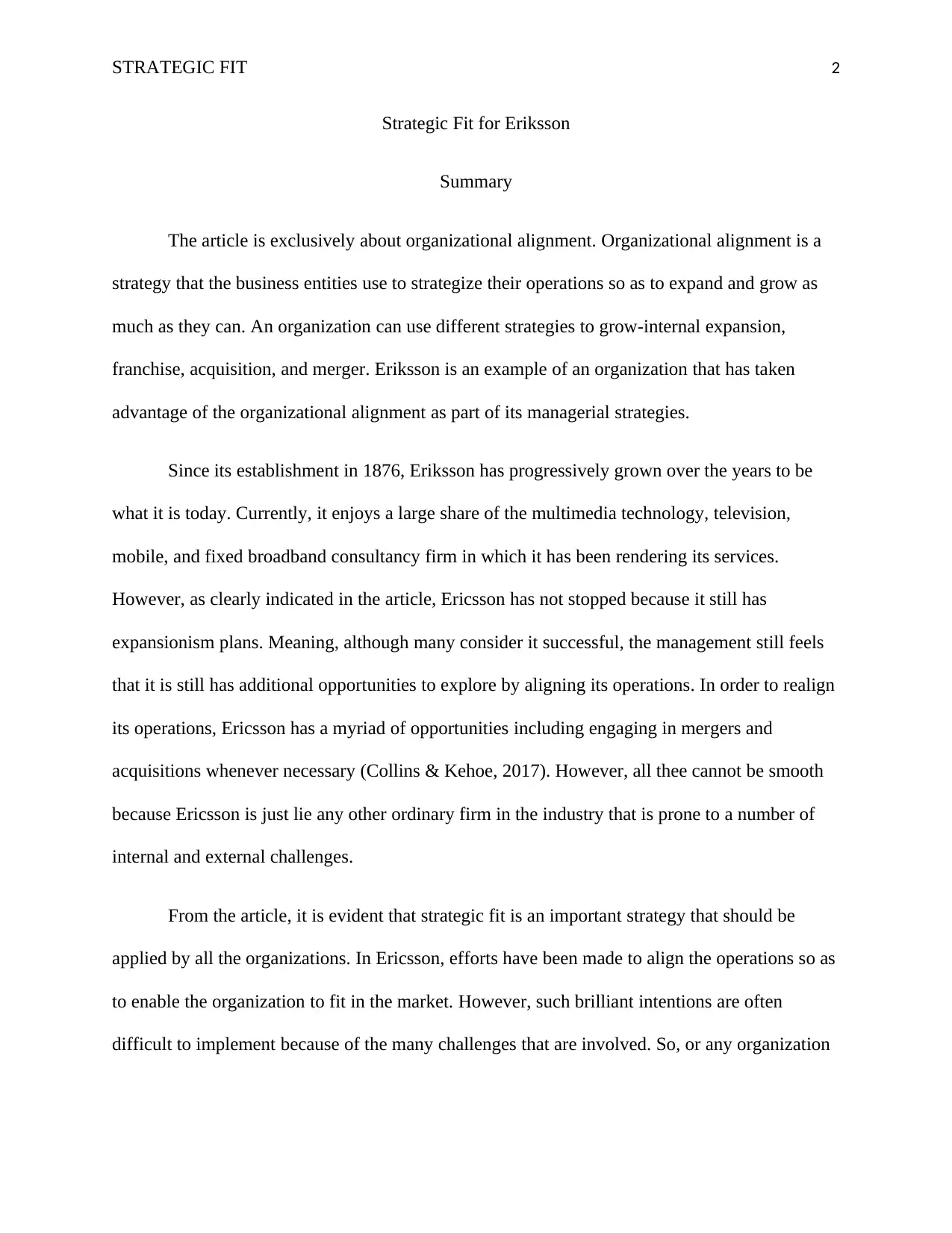
STRATEGIC FIT 2
Strategic Fit for Eriksson
Summary
The article is exclusively about organizational alignment. Organizational alignment is a
strategy that the business entities use to strategize their operations so as to expand and grow as
much as they can. An organization can use different strategies to grow-internal expansion,
franchise, acquisition, and merger. Eriksson is an example of an organization that has taken
advantage of the organizational alignment as part of its managerial strategies.
Since its establishment in 1876, Eriksson has progressively grown over the years to be
what it is today. Currently, it enjoys a large share of the multimedia technology, television,
mobile, and fixed broadband consultancy firm in which it has been rendering its services.
However, as clearly indicated in the article, Ericsson has not stopped because it still has
expansionism plans. Meaning, although many consider it successful, the management still feels
that it is still has additional opportunities to explore by aligning its operations. In order to realign
its operations, Ericsson has a myriad of opportunities including engaging in mergers and
acquisitions whenever necessary (Collins & Kehoe, 2017). However, all thee cannot be smooth
because Ericsson is just lie any other ordinary firm in the industry that is prone to a number of
internal and external challenges.
From the article, it is evident that strategic fit is an important strategy that should be
applied by all the organizations. In Ericsson, efforts have been made to align the operations so as
to enable the organization to fit in the market. However, such brilliant intentions are often
difficult to implement because of the many challenges that are involved. So, or any organization
Strategic Fit for Eriksson
Summary
The article is exclusively about organizational alignment. Organizational alignment is a
strategy that the business entities use to strategize their operations so as to expand and grow as
much as they can. An organization can use different strategies to grow-internal expansion,
franchise, acquisition, and merger. Eriksson is an example of an organization that has taken
advantage of the organizational alignment as part of its managerial strategies.
Since its establishment in 1876, Eriksson has progressively grown over the years to be
what it is today. Currently, it enjoys a large share of the multimedia technology, television,
mobile, and fixed broadband consultancy firm in which it has been rendering its services.
However, as clearly indicated in the article, Ericsson has not stopped because it still has
expansionism plans. Meaning, although many consider it successful, the management still feels
that it is still has additional opportunities to explore by aligning its operations. In order to realign
its operations, Ericsson has a myriad of opportunities including engaging in mergers and
acquisitions whenever necessary (Collins & Kehoe, 2017). However, all thee cannot be smooth
because Ericsson is just lie any other ordinary firm in the industry that is prone to a number of
internal and external challenges.
From the article, it is evident that strategic fit is an important strategy that should be
applied by all the organizations. In Ericsson, efforts have been made to align the operations so as
to enable the organization to fit in the market. However, such brilliant intentions are often
difficult to implement because of the many challenges that are involved. So, or any organization
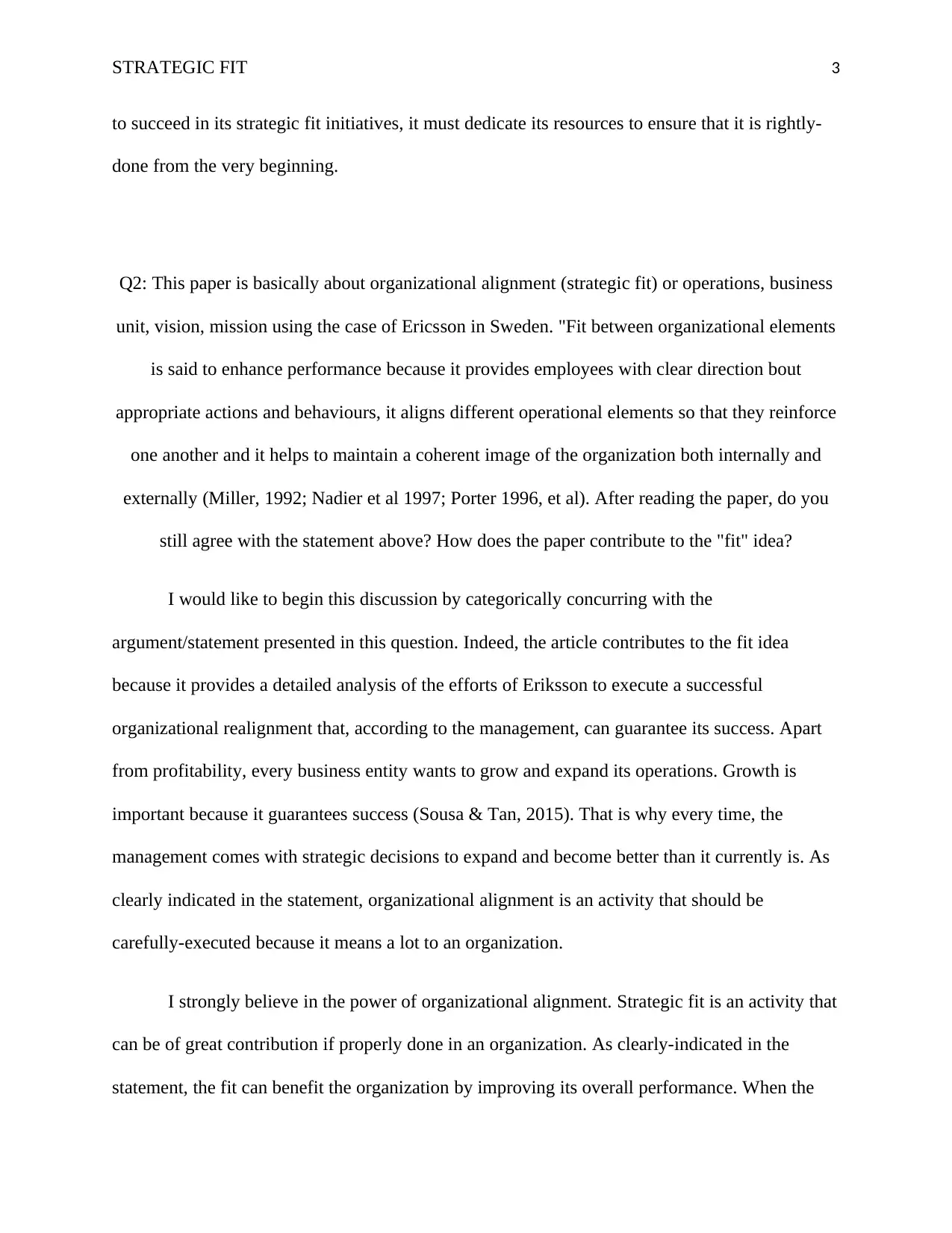
STRATEGIC FIT 3
to succeed in its strategic fit initiatives, it must dedicate its resources to ensure that it is rightly-
done from the very beginning.
Q2: This paper is basically about organizational alignment (strategic fit) or operations, business
unit, vision, mission using the case of Ericsson in Sweden. "Fit between organizational elements
is said to enhance performance because it provides employees with clear direction bout
appropriate actions and behaviours, it aligns different operational elements so that they reinforce
one another and it helps to maintain a coherent image of the organization both internally and
externally (Miller, 1992; Nadier et al 1997; Porter 1996, et al). After reading the paper, do you
still agree with the statement above? How does the paper contribute to the "fit" idea?
I would like to begin this discussion by categorically concurring with the
argument/statement presented in this question. Indeed, the article contributes to the fit idea
because it provides a detailed analysis of the efforts of Eriksson to execute a successful
organizational realignment that, according to the management, can guarantee its success. Apart
from profitability, every business entity wants to grow and expand its operations. Growth is
important because it guarantees success (Sousa & Tan, 2015). That is why every time, the
management comes with strategic decisions to expand and become better than it currently is. As
clearly indicated in the statement, organizational alignment is an activity that should be
carefully-executed because it means a lot to an organization.
I strongly believe in the power of organizational alignment. Strategic fit is an activity that
can be of great contribution if properly done in an organization. As clearly-indicated in the
statement, the fit can benefit the organization by improving its overall performance. When the
to succeed in its strategic fit initiatives, it must dedicate its resources to ensure that it is rightly-
done from the very beginning.
Q2: This paper is basically about organizational alignment (strategic fit) or operations, business
unit, vision, mission using the case of Ericsson in Sweden. "Fit between organizational elements
is said to enhance performance because it provides employees with clear direction bout
appropriate actions and behaviours, it aligns different operational elements so that they reinforce
one another and it helps to maintain a coherent image of the organization both internally and
externally (Miller, 1992; Nadier et al 1997; Porter 1996, et al). After reading the paper, do you
still agree with the statement above? How does the paper contribute to the "fit" idea?
I would like to begin this discussion by categorically concurring with the
argument/statement presented in this question. Indeed, the article contributes to the fit idea
because it provides a detailed analysis of the efforts of Eriksson to execute a successful
organizational realignment that, according to the management, can guarantee its success. Apart
from profitability, every business entity wants to grow and expand its operations. Growth is
important because it guarantees success (Sousa & Tan, 2015). That is why every time, the
management comes with strategic decisions to expand and become better than it currently is. As
clearly indicated in the statement, organizational alignment is an activity that should be
carefully-executed because it means a lot to an organization.
I strongly believe in the power of organizational alignment. Strategic fit is an activity that
can be of great contribution if properly done in an organization. As clearly-indicated in the
statement, the fit can benefit the organization by improving its overall performance. When the
⊘ This is a preview!⊘
Do you want full access?
Subscribe today to unlock all pages.

Trusted by 1+ million students worldwide
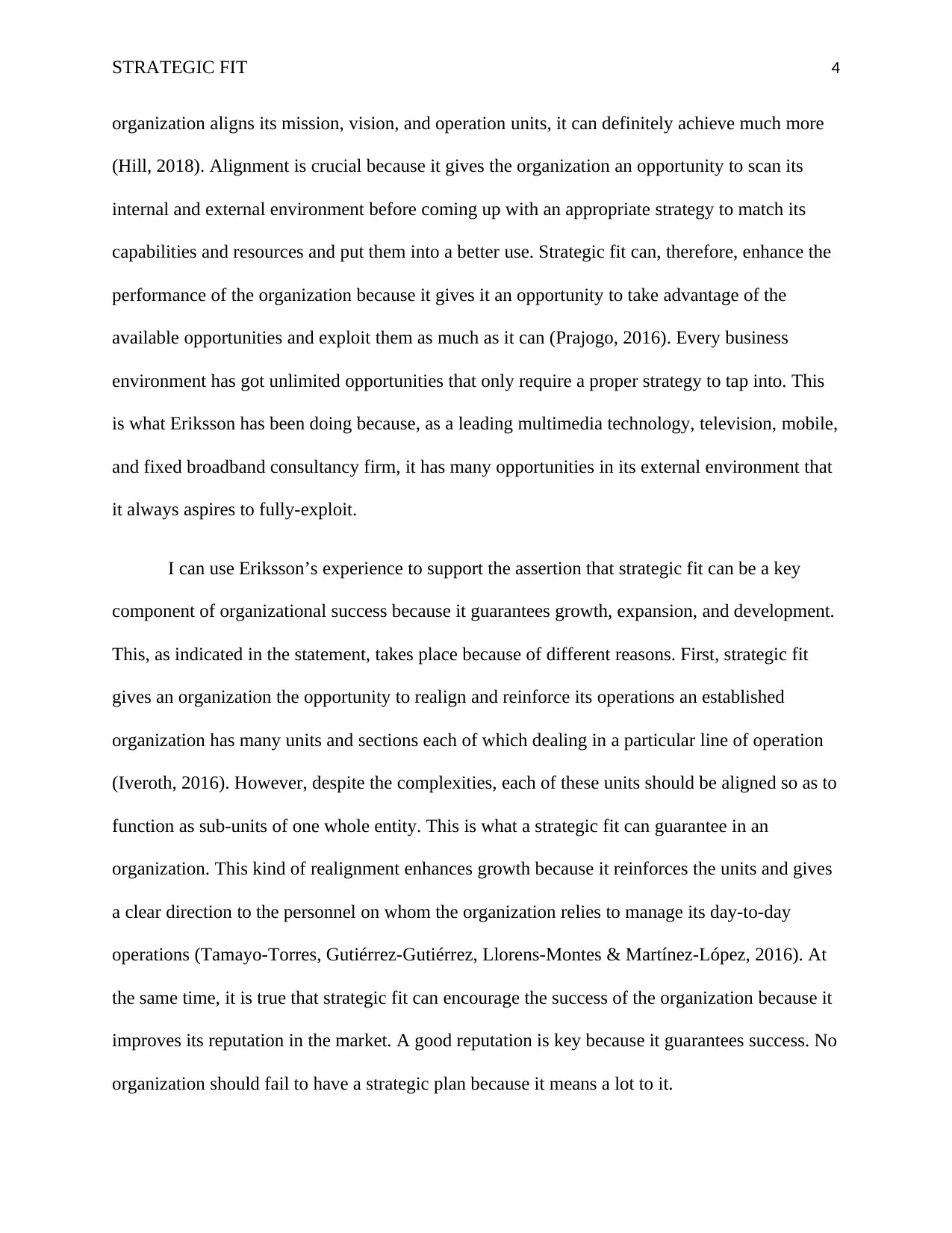
STRATEGIC FIT 4
organization aligns its mission, vision, and operation units, it can definitely achieve much more
(Hill, 2018). Alignment is crucial because it gives the organization an opportunity to scan its
internal and external environment before coming up with an appropriate strategy to match its
capabilities and resources and put them into a better use. Strategic fit can, therefore, enhance the
performance of the organization because it gives it an opportunity to take advantage of the
available opportunities and exploit them as much as it can (Prajogo, 2016). Every business
environment has got unlimited opportunities that only require a proper strategy to tap into. This
is what Eriksson has been doing because, as a leading multimedia technology, television, mobile,
and fixed broadband consultancy firm, it has many opportunities in its external environment that
it always aspires to fully-exploit.
I can use Eriksson’s experience to support the assertion that strategic fit can be a key
component of organizational success because it guarantees growth, expansion, and development.
This, as indicated in the statement, takes place because of different reasons. First, strategic fit
gives an organization the opportunity to realign and reinforce its operations an established
organization has many units and sections each of which dealing in a particular line of operation
(Iveroth, 2016). However, despite the complexities, each of these units should be aligned so as to
function as sub-units of one whole entity. This is what a strategic fit can guarantee in an
organization. This kind of realignment enhances growth because it reinforces the units and gives
a clear direction to the personnel on whom the organization relies to manage its day-to-day
operations (Tamayo-Torres, Gutiérrez-Gutiérrez, Llorens-Montes & Martínez-López, 2016). At
the same time, it is true that strategic fit can encourage the success of the organization because it
improves its reputation in the market. A good reputation is key because it guarantees success. No
organization should fail to have a strategic plan because it means a lot to it.
organization aligns its mission, vision, and operation units, it can definitely achieve much more
(Hill, 2018). Alignment is crucial because it gives the organization an opportunity to scan its
internal and external environment before coming up with an appropriate strategy to match its
capabilities and resources and put them into a better use. Strategic fit can, therefore, enhance the
performance of the organization because it gives it an opportunity to take advantage of the
available opportunities and exploit them as much as it can (Prajogo, 2016). Every business
environment has got unlimited opportunities that only require a proper strategy to tap into. This
is what Eriksson has been doing because, as a leading multimedia technology, television, mobile,
and fixed broadband consultancy firm, it has many opportunities in its external environment that
it always aspires to fully-exploit.
I can use Eriksson’s experience to support the assertion that strategic fit can be a key
component of organizational success because it guarantees growth, expansion, and development.
This, as indicated in the statement, takes place because of different reasons. First, strategic fit
gives an organization the opportunity to realign and reinforce its operations an established
organization has many units and sections each of which dealing in a particular line of operation
(Iveroth, 2016). However, despite the complexities, each of these units should be aligned so as to
function as sub-units of one whole entity. This is what a strategic fit can guarantee in an
organization. This kind of realignment enhances growth because it reinforces the units and gives
a clear direction to the personnel on whom the organization relies to manage its day-to-day
operations (Tamayo-Torres, Gutiérrez-Gutiérrez, Llorens-Montes & Martínez-López, 2016). At
the same time, it is true that strategic fit can encourage the success of the organization because it
improves its reputation in the market. A good reputation is key because it guarantees success. No
organization should fail to have a strategic plan because it means a lot to it.
Paraphrase This Document
Need a fresh take? Get an instant paraphrase of this document with our AI Paraphraser
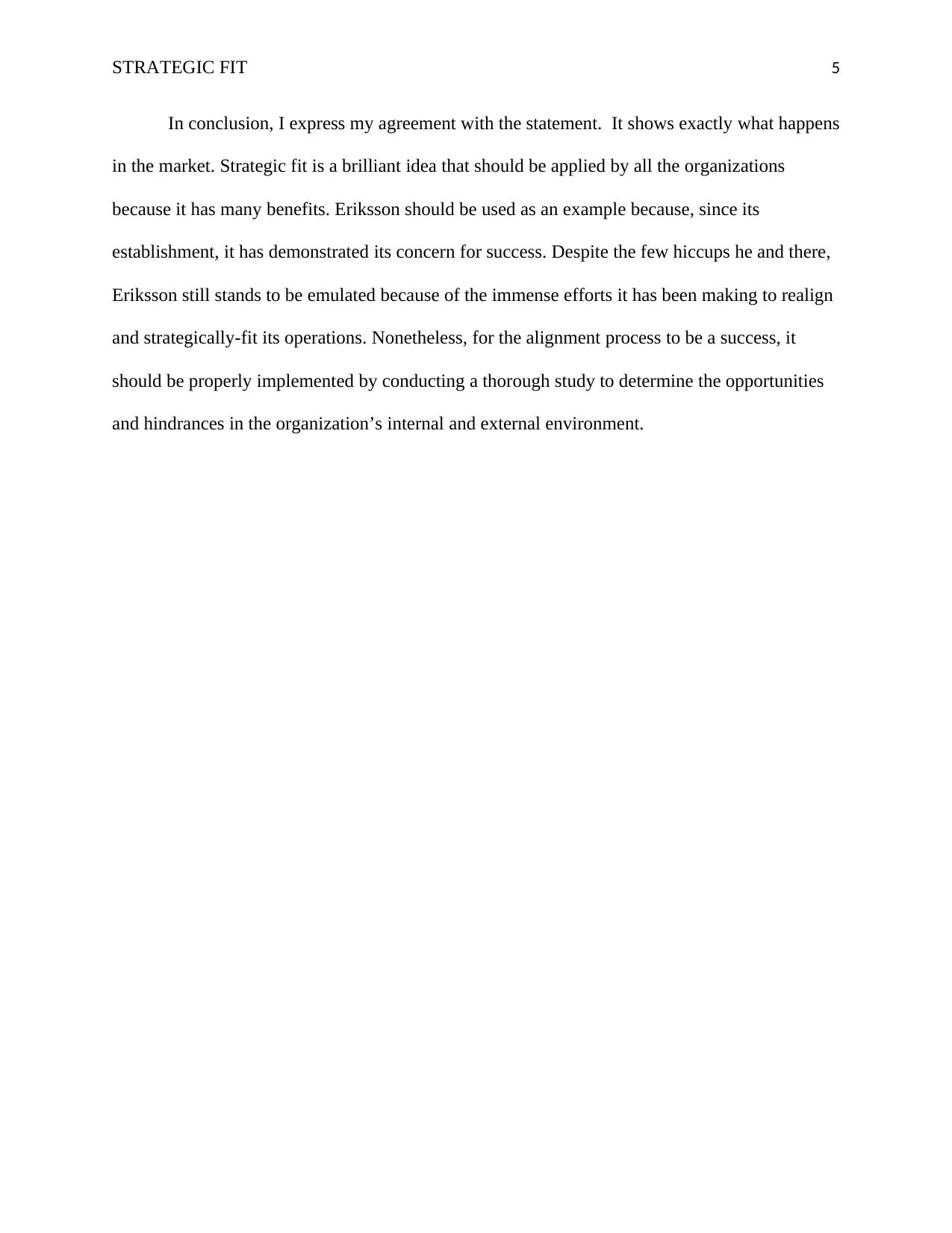
STRATEGIC FIT 5
In conclusion, I express my agreement with the statement. It shows exactly what happens
in the market. Strategic fit is a brilliant idea that should be applied by all the organizations
because it has many benefits. Eriksson should be used as an example because, since its
establishment, it has demonstrated its concern for success. Despite the few hiccups he and there,
Eriksson still stands to be emulated because of the immense efforts it has been making to realign
and strategically-fit its operations. Nonetheless, for the alignment process to be a success, it
should be properly implemented by conducting a thorough study to determine the opportunities
and hindrances in the organization’s internal and external environment.
In conclusion, I express my agreement with the statement. It shows exactly what happens
in the market. Strategic fit is a brilliant idea that should be applied by all the organizations
because it has many benefits. Eriksson should be used as an example because, since its
establishment, it has demonstrated its concern for success. Despite the few hiccups he and there,
Eriksson still stands to be emulated because of the immense efforts it has been making to realign
and strategically-fit its operations. Nonetheless, for the alignment process to be a success, it
should be properly implemented by conducting a thorough study to determine the opportunities
and hindrances in the organization’s internal and external environment.
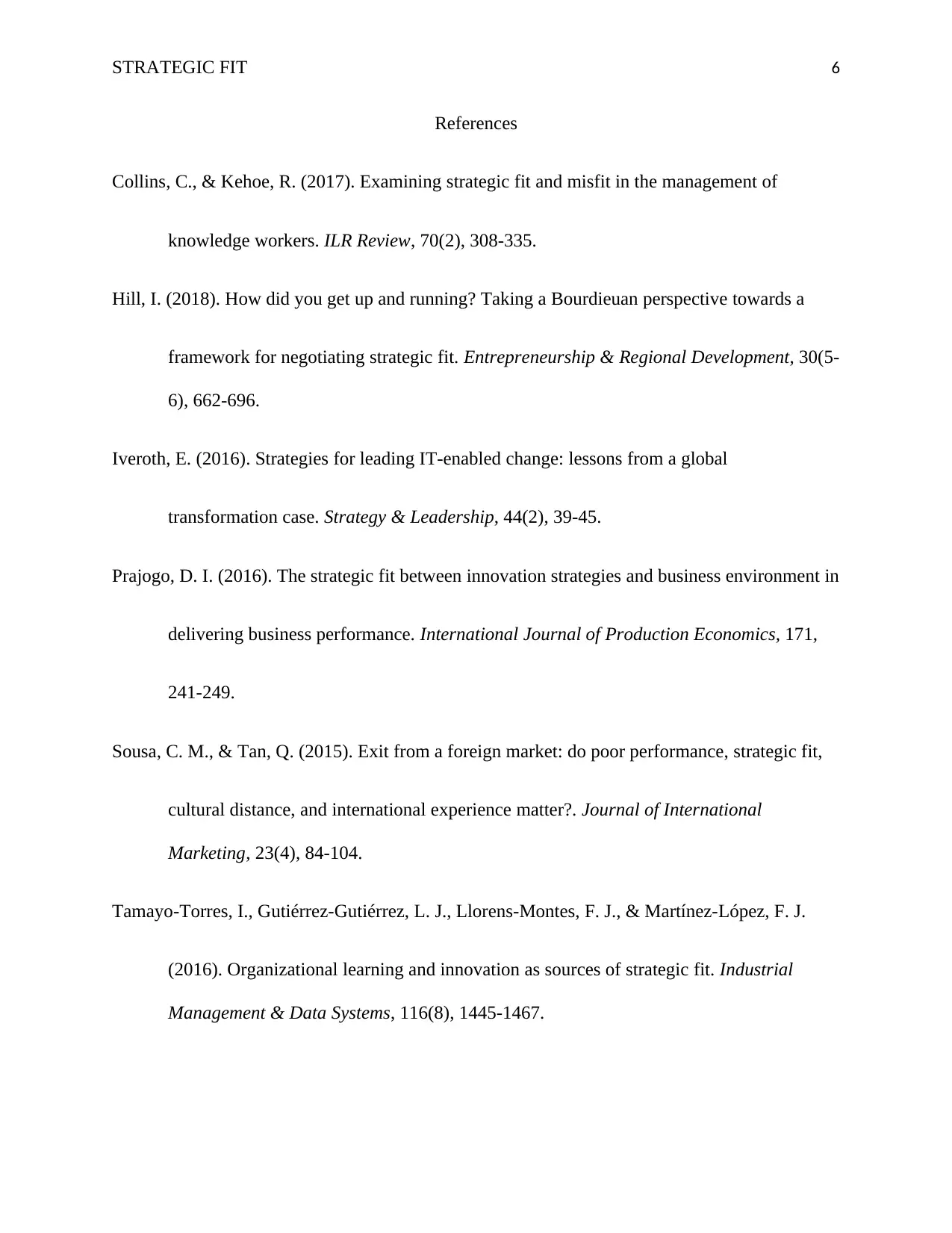
STRATEGIC FIT 6
References
Collins, C., & Kehoe, R. (2017). Examining strategic fit and misfit in the management of
knowledge workers. ILR Review, 70(2), 308-335.
Hill, I. (2018). How did you get up and running? Taking a Bourdieuan perspective towards a
framework for negotiating strategic fit. Entrepreneurship & Regional Development, 30(5-
6), 662-696.
Iveroth, E. (2016). Strategies for leading IT-enabled change: lessons from a global
transformation case. Strategy & Leadership, 44(2), 39-45.
Prajogo, D. I. (2016). The strategic fit between innovation strategies and business environment in
delivering business performance. International Journal of Production Economics, 171,
241-249.
Sousa, C. M., & Tan, Q. (2015). Exit from a foreign market: do poor performance, strategic fit,
cultural distance, and international experience matter?. Journal of International
Marketing, 23(4), 84-104.
Tamayo-Torres, I., Gutiérrez-Gutiérrez, L. J., Llorens-Montes, F. J., & Martínez-López, F. J.
(2016). Organizational learning and innovation as sources of strategic fit. Industrial
Management & Data Systems, 116(8), 1445-1467.
References
Collins, C., & Kehoe, R. (2017). Examining strategic fit and misfit in the management of
knowledge workers. ILR Review, 70(2), 308-335.
Hill, I. (2018). How did you get up and running? Taking a Bourdieuan perspective towards a
framework for negotiating strategic fit. Entrepreneurship & Regional Development, 30(5-
6), 662-696.
Iveroth, E. (2016). Strategies for leading IT-enabled change: lessons from a global
transformation case. Strategy & Leadership, 44(2), 39-45.
Prajogo, D. I. (2016). The strategic fit between innovation strategies and business environment in
delivering business performance. International Journal of Production Economics, 171,
241-249.
Sousa, C. M., & Tan, Q. (2015). Exit from a foreign market: do poor performance, strategic fit,
cultural distance, and international experience matter?. Journal of International
Marketing, 23(4), 84-104.
Tamayo-Torres, I., Gutiérrez-Gutiérrez, L. J., Llorens-Montes, F. J., & Martínez-López, F. J.
(2016). Organizational learning and innovation as sources of strategic fit. Industrial
Management & Data Systems, 116(8), 1445-1467.
⊘ This is a preview!⊘
Do you want full access?
Subscribe today to unlock all pages.

Trusted by 1+ million students worldwide
1 out of 6
Related Documents
Your All-in-One AI-Powered Toolkit for Academic Success.
+13062052269
info@desklib.com
Available 24*7 on WhatsApp / Email
![[object Object]](/_next/static/media/star-bottom.7253800d.svg)
Unlock your academic potential
Copyright © 2020–2025 A2Z Services. All Rights Reserved. Developed and managed by ZUCOL.





